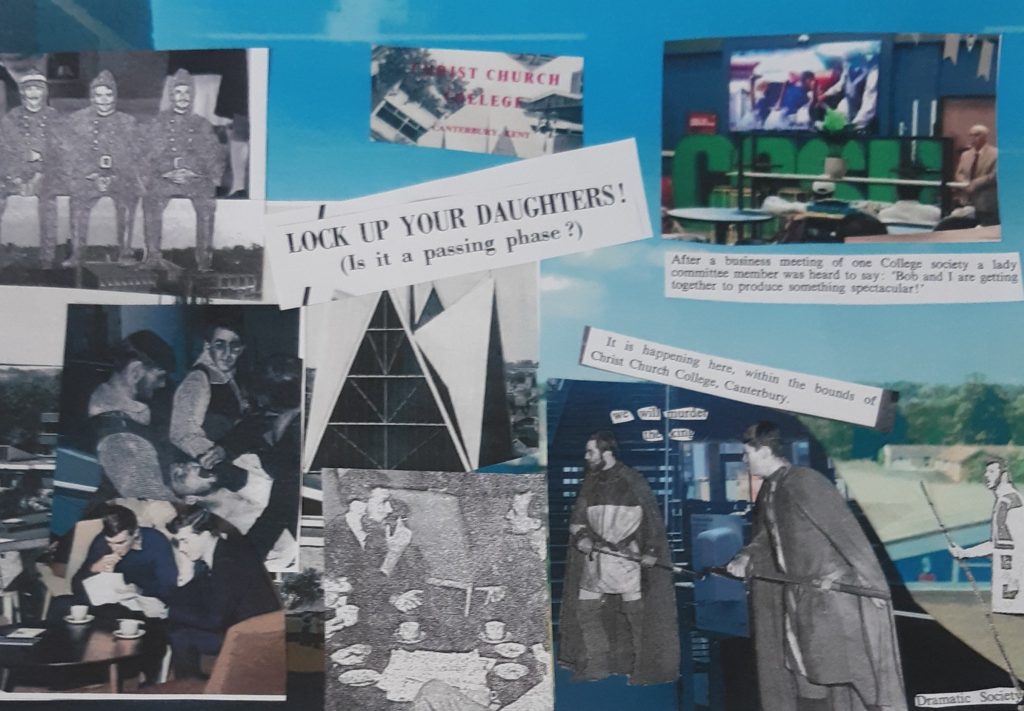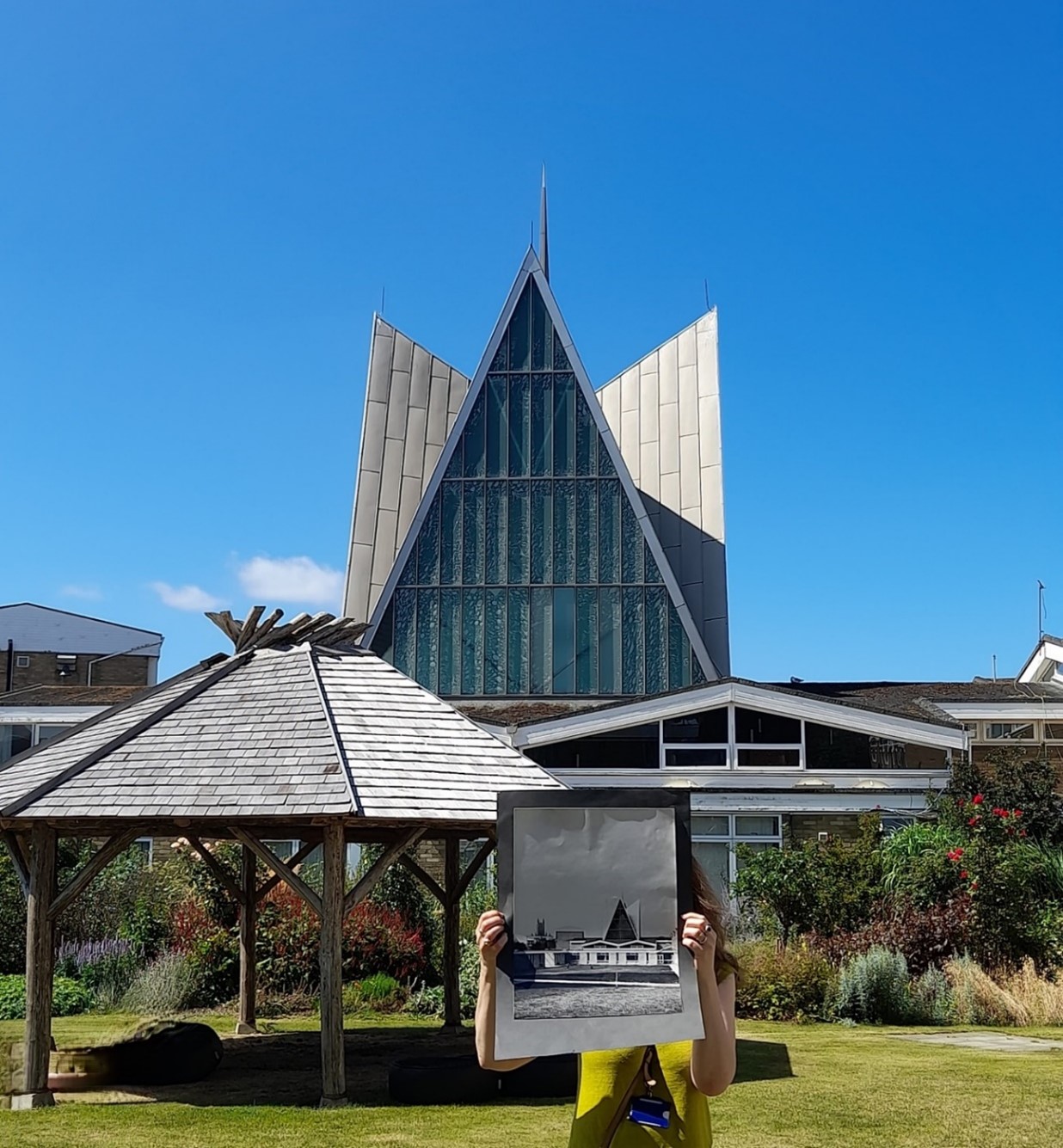Our latest archival zine project was taken on by student volunteers Angie Majnic-Lane and Evie Loos-Page. The zine is available to download now, so here’s what the experience was like for them, in their own words:
Over the past few weeks, we have been delving into the archives and sorting through newspapers, magazines and photographs to uncover what life was like at Christ Church University in the 1960s, and we have made some truly fascinating and thought-provoking discoveries. We began by reading several old newspaper articles detailing the construction and opening of the university, from which we learnt that it was originally a Church of England teacher training college. The college affirmed that it was dedicated to producing teachers with strong Christian values. The Archdeacon was quoted in the Kentish Gazette (June 1961) saying that the college must produce “the right kind of Christian teacher” who will “go into the world with a firm faith and conviction to teach every subject, as being of importance to God”.
Whilst the Archbishop of Canterbury is currently the University’s Chancellor, CCCU is now open to students of all faiths. The chapel may still be the central focal point of campus, with its unique steeple that was considered excitingly modern, “unusual”, and “impressive” when it was first built in the 1960’s, but there is less of an emphasis on Christianity being the primary practiced religion with the inclusion of multi-faith prayer rooms around the campus.
We found a few rather salacious student-published Rag Mags [1] , which came as a surprise. These included photos from a student swimwear beauty pageant and various crude cartoons, jokes and poems. The ways in which women were discussed and presented in these magazines prompted us to further investigate the gendered history of students and consider how attitudes differ nowadays.
Carol Dyhouse’s text Students: A Gendered History[2] informed us of the general expectations placed upon female students in the 1960s, who were not only presumed to be entirely celibate, but unmarried before they graduated. One woman is quoted saying that her thesis supervisor “truly believed that women scholars should be nuns, renouncing the body for higher things” (A.S.Bryatt) [3]. There was an intense concern over women becoming pregnant during their studies, and female students who had sex faced much harsher punishments than male students. One example from Dyhouse is of a woman named Cathy, who, when found in bed with her boyfriend was kicked out of St Hilda’s college Oxford, lost her grant, and was also prevented from obtaining a place at another university. Meanwhile, her boyfriend was only sent away from his college for two weeks. Cathy’s life was ruined by one action, while her boyfriend faced little consequences. This excessive scrutiny of women is evident in materials available in the archives.
In a Christ Church College Student Union published magazine titled ‘Cephor’, we found an intriguing piece regarding the positioning of the nearby prison, termed “sin bin”, situated with a view of the female student’s dormitory. The article opens in a bizarre manner, essentially stating that the male prisoners are sexually ravenous and depraved as a result of the beautiful young women being dangled in front of them, ever out of their reach. It goes on to suggest that some of the women enjoyed the perverse attention and had been provoking the men by waving at them. As it turns out, the women who waved at the prisoners were simply trying to be polite and felt sympathy for them, believing them to be lonely. It is a rather long-winded article that ultimately concludes that the women’s bedrooms need net curtains to protect their privacy.
The same magazine featured an article stating that contraceptives should be withheld from unmarried students; their reasoning seemed to be that unmarried students should be celibate, and therefore have no need for it. This is all rather hypocritical when you consider how vehemently against pregnancy universities were at the time. Universities were so reluctant to provide it that those that did were referred to as “enlightened”. Even then, those universities probably only provided it because they felt pressured to prevent their married students from becoming pregnant, dropping out, and subsequently tarnishing their reputation. As we discovered in a separate article from the Kentish Gazette (1969), nearly half of the third-year students training to be art teachers were married, so the chances of them having children were certainly higher than those of the unmarried students.

An excerpt of a draft page from the zine
Attitudes were certainly not the only thing changing, the campus itself was constantly undergoing new exciting developments, resulting in the campus we know and love today. The archive itself was filled with an abundance of photographs taken of the campus in the 1960s, and we thought it would be fascinating to recreate these photos on modern day campus, to help us visualise the passing of time and any significant changes. Many of the archive materials documented the development of the college and the original layout of CCCU’s campus. We found that the library used to be at the heart of campus, spanning the area which is now Touchdown café and Laud. The student dorms were also on campus, with the men living in Fynden and Thorne, the women in a building where the new Verena Holmes block now stands, and there was extra “hostel” accommodation in Fisher tower. The women’s accommodation had a view of the chapel and the cathedral, but also the prison. When we ventured to campus, we took some photos from the 60’s with us and tried to incorporate these into our pictures of the modern-day views.
Having tried to recreate the shots, we spliced together both the old and the new photos to create collages for this zine, to comment on important themes which emerged from the archive materials: theatre, architecture, religion, gender, and marriage. These themes inspired our further reading and research, and you will find examples of what we found dotted throughout the zine. We were surprised how many interesting themes emerged from the newspaper clippings and how much they illuminated how student life at Canterbury Christ Church has changed in the last 60 years.
[1] See in the archive: 1965, Target; 1966, Target; East Kent Student Carnival.
[2] Dyhouse, Carol., 2005. Students: A gendered history. London: Routledge.
[3] A.S.Bryatt in: Dyhouse, Carol., 2005. Students: A gendered history. London: Routledge.
Words & Photos: Angie Majnic-Lane and Evie Loos-Page.
If you would like to volunteer for future Archives projects, or find out more, please do email us to find out more.
 Library
Library Bob Henderson
Bob Henderson 1124
1124


